 |
|

|
 |
TABLE of CONTENTS
|
Community dedicates realigned Hwy 53, new bridge in Virginia |
By Kevin Gutknecht
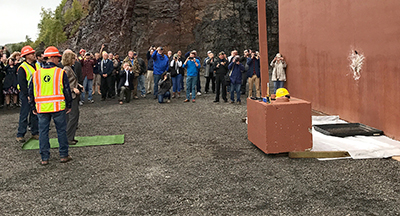
Lt. Gov. Tina Smith christens the Hwy 53 bridge with a bottle of white wine at the Sept. 15 ceremony, marking the opening of the new highway segment. Photo courtesy of District 1 |
Lt. Gov. Tina Smith and U.S. Rep. Rick Nolan joined Commissioner Charlie Zelle and local leaders Sept. 15 in Virginia to mark the completion of the Hwy 53 relocation project. Shortly after 11 a.m., officials cut a ribbon under the bridge and announced that the new roadway and bridge were ready for service.
“This bridge represents new opportunities for Range businesses, families and communities, including new options for transportation and recreation,” said Smith. “I thank the workers who put thousands of hours into the construction of the bridge, as well as the partnership of Cliffs Natural Resources and RGGS Land & Minerals, for making this project a reality.”
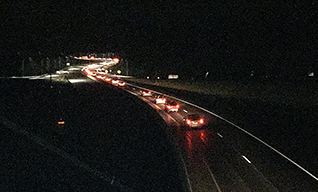
The new section of Hwy 53 opened for traffic Sept.16 at 9:57 p.m. Photo courtesy of District 1 |
The $156 million project includes more than three miles of new four-lane roadway and a 1,100 foot long bridge that is one of the highest state-owned bridges in Minnesota. The bridge is a steel beam design with a concrete deck. The new alignment of the Mesabi Trail recreation facility runs along the roadway right of way and crosses the pit on the bridge.
“What we have here today is not only the tallest bridge in Minnesota… it is one of finest bridges you will see anywhere,” said Nolan.
The bridge spans the Rouchleau Pit, an abandoned iron ore mine on the south side of Virginia. Construction was challenged by rock waste left from mining as well as some of the hardest rock encountered in Minnesota. More than 100 construction workers labored for a total of 165,000 hours over two years to build the structure, moving hundreds of thousands of yards of soil and rock to build the new roadway. Crews drilled and installed thousands of feet of steel piling, anchored into bedrock to create a sturdy foundation for the bridge.
|
This video of the Hwy 53 relocation project in Virgina is a time-lapse of the project and drone footage of the entire section of the highway. |
The project was necessary because the original roadway was built on mining property. More than 50 years ago, the mining interests that owned the land agreed to let the state build a roadway, provided the transportation agency would move the road if the mining company needed to get to the ore.
In 2010, the mining company alerted MnDOT that it needed to access the ore. MnDOT developed a plan to move the road by 2017.
For photos, a video of opening ceremony and background information, see the project website.
|
 |
|

|
 |
TABLE of CONTENTS
 |
Zelle travels southeast Minnesota with Commissioners on Wheels tour |
By Mike Dougherty, District 6 public affairs coordinator
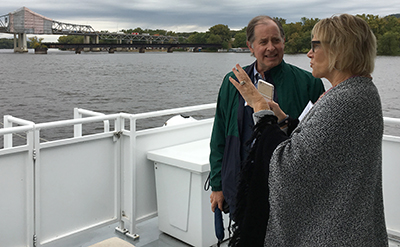
Commissioner Charlie Zelle talks with Kari Howe of the Minnesota Department of Employment and Economic Development during a boat tour Sept. 18 on the Mississippi River in Winona that was part of the Commissioners on Wheels tour. Photo by Mike Dougherty |
Each year Minnesota’s state agency commissioners board a bus to tour a region of the state, visiting industry leaders, small companies and communities to learn more about the region, its people and the type of businesses that make it tick.
The Commissioners on Wheels tour, spearheaded by the Department of Employment and Economic Development’s Business First Stop, made its way through the Mississippi River valley, bluff country and rolling farmland of southeast Minnesota Sept. 18-20.
Commissioner Charlie Zelle was among the participants, helping introduce stops that included key transportation efforts, such as the Winona Bridge project.
Zelle was among seven agency commissioners on the three-day tour that made stops in Hastings, Red Wing, Winona, Whitewater State Park, St. Charles, Lanesboro, Chatfield, Rochester, Austin, Claremont, Owatonna and Faribault.
“This is a good event for all of us, because we get to see and hear the perspectives on the economy from a number of key leaders in a region of the state,” Zelle said. “I look at it through our lens of transportation and may hear ways we can help or improve their efforts, which, in turn, helps the economy.”
Each day included site visits to companies such as the Red Wing Shoe Co. or Current Designs, a kayak manufacturer in Winona, as well as stops to hear from community and business leaders along the way and on the bus. Each day had about 12 hours of programs and visits mixed in with the travel.
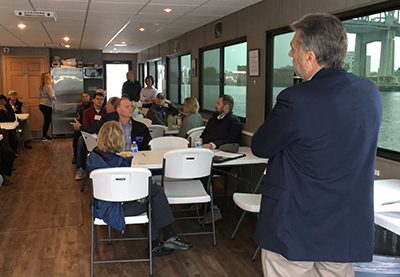
Jeff Vlaminck, District 6 engineer, talks about the Winona Bridge project Sept. 18 during Commissioners on Wheels boat tour on the Mississippi River. Photo by Mike Dougherty |
Zelle talked about transportation funding issues with Rep. Gene Pelowski, of Winona, as the group took a boat tour to review the Hwy 43 bridge project and the Winona Port.
District 6 Engineer Jeff Vlaminck toured with the group and offered information and insights into transportation projects that the commissioners traveled past or visited.
“This tour is a good event, especially as we prepare to launch our District 6 Manufacturer’s Perspectives survey in our region, touching some of the same places we’ve been visiting with the Commissioners on Wheels tour,” Vlaminck said.
Vlaminck also talked about MnDOT’s first use of the Construction Manager/General Contractor procurement method, which was used with the Winona Bridge project. He said CMGC helped the project begin earlier and adjust as challenges emerged by dividing project into six bid packages. |
 |
|

|
 |
TABLE of CONTENTS
 |
10 initiatives to make Minnesota work zones safer |
|
By Research Services staff
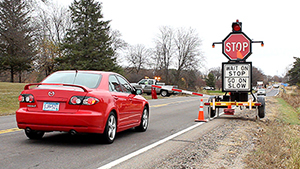
The Automated Flagger Assistance Device controls traffic while keeping workers out of harm’s way. Initially piloted as a stationary device, pictured here in District 3, the equipment was recently upgraded to be self-propelled for moving operations like crack-sealing. Photo by Nick Busse |
Work zones are one of the most hazardous places to be on the road – for drivers and highway workers. Each year in Minnesota, an average of seven people die in work zone crashes and 753 fatal or serious injury crashes occur. With work zone crashes on the rise across the nation, here’s a recap on MnDOT’s current initiatives to improve work zone safety.
1. Using Smartphones to Alert Drivers to Work Zones
Imagine that you’re driving to work when your smartphone announces, “Caution, you are approaching an active work zone.” You slow down and soon spot orange barrels and highway workers on the road shoulder. Thanks to a new app being developed by the University of Minnesota for MnDOT, this scenario is on its way to becoming reality. (Recent testing confirmed the messages aren’t distracting to drivers.) Read up on the latest research to learn more.
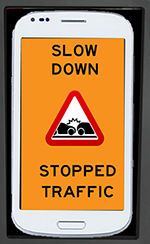
New smartphone app will warn drivers of upcoming work zones. |
2. Wearable Detection Vests for Construction Workers Motor vehicles aren’t the only threat to worker safety. Construction vehicles themselves can be a hazard. A prototype warning system developed for MnDOT embeds portable Global Positioning System receivers in worker safety vests to show construction equipment operators exactly where workers are located. They could also be used to warn motor vehicle drivers that workers are present and set appropriate speed limits. More refinement of the prototype is needed to improve its directional accuracy and reduce the size of the receivers.
3. Self-Propelled AFAD Keeps Flaggers Safely Off the Road In 2014, MnDOT trained over 60 maintenance workers in the use of an automated flagger assistance device (AFAD) that signals traffic remotely by a worker who can stand off the roadway, out of harm’s way. Working with a Minnesota manufacturer, researchers have now developed a mobile version that doesn’t require towing and can be used for moving operations like crack-sealing. (Further modifications are expected to improve its performance.) The device was featured in September’s Roads & Bridges magazine.
4. Personal Warning Sensor that Alerts Workers to Vehicle Intrusion
Researchers are developing a state-of-the-art work zone intrusion and worker alarm system to deploy within work crews nationally, including those in Minnesota. The technology can intelligently detect and track potential vehicle intrusion threats as well as worker locations in the work zone. If an intrusion has occurred or is imminent, workers who are at risk are alerted via a small device worn in the hardhat, in the vest, or as an armband. The device provides haptic and auditory alerts of an impending intrusion.
5. Smartphone App for Visually Impaired Pedestrians
Audible messages delivered through smartphones could help visually impaired pedestrians safely navigate through or around work zones. The new system uses Bluetooth beacons attached to work zone infrastructure that send messages to a pedestrian's smartphone app rather than the traditional method of beeping buttons that announce a message when pressed. The technology now being patented by the University of Minnesota includes intersection crossing information.
These aren’t the only efforts under way to improve work zone safety. Check out these other MnDOT research projects:
• Evaluation of the Smart Work Zone Speed Notification System
• Use of Positive Protection in Work Zones
• Guides for Choosing Work Zone Layouts for Low-Volume Roads
• Speed Cameras Not a Driver Distraction in Work Zones
• Managing Work Zone Delays by Improved Estimation of Traffic Diversion and Capacity
|
 |
|

|
|

|
 |
TABLE of CONTENTS
 |
WIG Spotlight: Offices advance equity attracting targeted group, veteran-owned businesses |
|
By Adrienne Bond, Office of Civil Rights
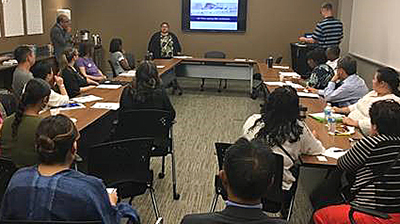
DeLores Aguirre, small business contracting team lead from the Office of Civil Rights, informs business owners about the certification process and the benefits of certification at a recent training at MnDOT’s Small Business Resource Center on Sept. 11. Photo by Orlanda Klinkhammer |
When people hear about the Targeted Group Business Program, Veteran-Owned Small Business Program, or even the Disadvantaged Business Enterprise Program, the instinct might be to think of construction firms.
However, thanks to WIG efforts by the Office of Transportation System Management, as well as other offices within the agency, MnDOT is seeing expanded opportunities to hire small businesses and advance equity for the organization and communities.
OTSM has been working on a WIG initiative to identify businesses that may meet the criteria for certification but are not yet certified. OTSM has collaborated with the Office of Civil Rights, which sponsored a training about the certification process and the benefits of certification at MnDOT’s Small Business Resource Center in September.
The Targeted Group Business Program provides women-owned and minority-owned small businesses increased access to state contracting opportunities. The Veteran-Owned Small Business Program provides Minnesota-based businesses that are at least 51 percent owned by veterans increased access to state contracting opportunities. The Office of Equity in Procurement in the Department of Administration certifies Targeted Group Businesses. The Minnesota Department of Veterans Affairs verifies the veteran ownership of the certified VET businesses.
Why is this important?
“MnDOT employees should seek certified small businesses because hiring these small businesses carries out MnDOT’s commitment to equal opportunity contracting,” said Betsy Parker, Chief Counsel and co-champion of the advancing equity priority in WIG 2.0. “It is fairer and makes contracting opportunities available to everyone, not just the businesses we typically hire.”
If your office is hosting an event, ordering supplies or needs to contract out for services, one stop along your way should be the TGB/VET directory.
The directory is searchable by business name, keywords or work types. The directory is updated daily, so check back often for the newest additions.
“Using certified small businesses helps diverse small businesses grow and be successful; this makes our communities better,” said Parker.
How can you help?
• When you are purchasing a product or service, actively seek TGB and VET Businesses
• Take advantage of flexibility on purchases under $25,000 with “Equity Select” Contracting
• Connect minority-, women-, and Veteran-owned small businesses with the state’s TGB and VET programs
• Ensure TGB and VET firms are invited to outreach events
What other resources are available?
If you have questions about the TGB or VET programs, or about any of MnDOT’s Office of Civil Rights’ programs or services, please contact Adrienne Bond at 651-366-3015 or visit OCR’s website. |
 |
|

|
 |
TABLE of CONTENTS
 |
Get ready for WIG 2.0 Shout Out, Round 2 |
|
By Jocelyn Stein, Strategic Programs Director, WIG Team

Dwain Orr, District 7 Windom subarea, uses the ice machine that their winning WIG team chose as a work resource for the sub-WIG of responding to public concerns and complaints within 48 hours and developing a tracking method. Photo by Andy Bedbury |
Due to the popularity of the first WIG 2.0 round of “Shout Out” recognition this summer, we’re bringing back a second round of recognition for some friendly competition between WIG 2.0 teams across the state.
All sub-WIGs that have either been completed, or reached key milestones and documented in their sub-WIG tracker, are eligible to enter. (Teams who won in Round 1 are not eligible for entry in this round.)
Timeline
• Oct. 20: Deadline to enter your sub-WIG tracker information in SharePoint for Round 2
• Oct. 27 – Nov. 7: WIG Coaches will narrow the pool of finalists by confirming “Qualified” data in sub-WIG trackers
• Nov. 14 – Dec. 3: WIG Champions select winners from the pool of finalists
• Dec. 4: Winners announced at the face-to-face WIG report out. Winners notified.
• Dec. 13: Newsline article announcing Round 2 winners
• Dec. 5 - Dec. 31: Winning teams select resources for their work areas
• Month of December and early January: Video Services interview winning teams
• Month of January: Celebrations in local areas
• Jan. 29: Video preview for release
• Feb. 6: Notemailer to all employees sharing the Round 2 video
• Feb. 14: Newsline highlight with Shout Out, Round 2 video included for easy viewing
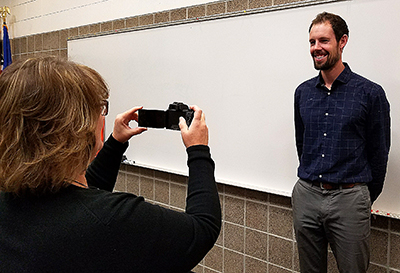
District 2 employees, Debbie Graves, human resources, practices taking a photo of Mark Bessler, training and development specialist, with the new Canon PowerShot G5 digital camera and connect station requested by the Admin/Human Resources WIG team for their winning sub-WIG to improve the new employee onboarding process for fulltime employees. Photo by TJ Melcher |
“The reason it’s important to promote WIG recognition is to motivate and recognize employees for their hard work and to increase full participation in the WIG and the 4 disciplines of execution,” said Sue Mulvihill, deputy commissioner and chief engineer and co-champion for WIG 2.0. “This is an important way to share the success of sub-WIG results and employee innovation that contribute to our overall goal of Earning Customer Trust.”
“I am so delighted by the incredible efforts we saw in the first round of Shout Out recognition. I can’t wait to see what folks put forward for this round,” said Tracy Hatch, deputy commissioner, CFO, COO and co-champion for WIG 2.0. “Reported results really demonstrate the way teams are increasing their communication and collaboration with each other and creating amazing results that can earn customer trust.”
WIG 2.0 teams: Work with your coach to get your sub-WIGs updated in SharePoint no later than Oct. 19. Your team could be the next one to be spotlighted for recognition! |
 |
|

|
 |
TABLE of CONTENTS
 |
Cassandra Isackson elected to National Association of State Aviation Officials board |
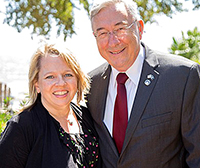
Isackson with newly elected NASAO chairman, Ronnie Mitchell, Nebraska. Photo by Kim Stevens |
Cassandra Isackson, Office of Aeronautics director, was elected vice president of the National Association of State Aviation Officials at their 86th annual convention and tradeshow in Alabama last week.
“My election to the executive board is a recognition of the good work of Aeronautics staff,” said Isackson. “Our 75 year partnership with airports throughout the state has created the best aviation system in the country. I’m happy to continue working with NASAO on issues of concern to Minnesotans.”
Elected to the board for 2017/2018 year along with Isackson were Ronnie Mitchell (Nebraska), chair; John Binder (Alaska), treasurer; and Merrill Atwater (Kansas), secretary.
|
 |
|

|
 |
TABLE of CONTENTS
 |
World Car Free Day is tomorrow—find out why your coworkers go car free |
By Dana Hernandez
MnDOT is participating in World Car Free Day Sept. 22, for the second year in a row. ABC Ramps and Move Minneapolis are again teaming up to promote the international movement in the Twin Cities, though greater Minnesota DOT employees can support the cause as well.
Other state entities, such as the Minnesota Pollution Control Agency, the Department of Natural Resources and Minnesota IT Services, are also supporting World Car Free Day.
The day is designed to encourage people to commute without relying on a single occupancy vehicle. For example, to use one less vehicle, you could carpool, ride your bike or take the bus to your destination.
MnDOT, ABC Ramps (owned by MnDOT) and Move Minneapolis believe in operating, maintaining and promoting sustainable and efficient transportation systems. This involves the community supporting Minnesota’s multimodal network.
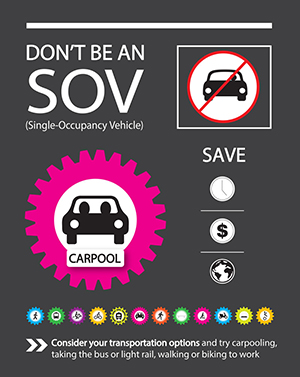
|
Taking alternative modes of transportation, whatever the reason, can help to reduce vehicle and fuel costs, shorten commute times, lower carbon footprints and relieve stress from driving alone.
Employees from across the state were asked why they frequently go car free…
Bryan Dodds, Metro District Operations and Maintenance
I mostly bike, sometimes walk, periodically run, and occasionally carpool or transit to work and to meetings at other work locations. I try to get some exercise every day and I find that being in the mindset that I won't take my car to work enables getting regular exercise while commuting. It also uses fewer resources and allows me to use and become experienced with other forms of transportation— providing much needed perspective for my job.
Jim Miles, District 1 Traffic Engineering
I bike to work most days rather than drive. My main reason for biking is to get exercise. I started biking when my kids were younger and they were involved in a lot of activities. I found myself struggling to find time to exercise. Biking to work only extends my commute time by about 15 to 20 minutes total for the day and I get some exercise without having to find time in my schedule. It’s now kind of a letdown when I need to drive.
Jeff Buschette, District 4 State Aid
I generally commute by bicycle several days a week and my commute is 2 miles (one way), so I only need to allow a few extra minutes to my driving time. Biking is fun, you get to enjoy being outdoors in the fresh air and arrive at work in a good mood, ready to start your work day. I recently purchased studded tires for my bike with the thought of extending my season into the winter months.
Ken Graeve, Central Office Environmental Stewardship
I bike to work most days—except for the occasions when I need to pick up the kids from school or sometimes in the winter, when the snow piles up too high, and the bike lanes have disappeared. I bike because climate change scares me a whole lot more than a little physical exertion. I also like to bike, and I don’t trust that I’d ever find time for exercise if it wasn’t just built in to my work day.
Les Bjerketvedt, District 4 Traffic
I choose to carpool with someone who works for a different agency, but in the same building as me. The commute is just over 50 miles, so carpooling saves gas and vehicle wear and tear.
Mike Ginnaty, District 2 engineer
I bike to work and it’s primarily for the exercise. Besides that, it’s enjoyable and the route I take is relaxing—it goes by some lakes and other nice scenery. It helps me unwind after a long day.
Sara Dunlap, Central Office Transit
I only live two miles away from work, but I like to bike or take the bus in the morning depending on how I am feeling. I like taking the bus because it’s on a set schedule, which makes me leave on time and get me to where I need to be on time. Sometimes I will walk home. I like to commute this way because it’s less stressful, and walking home is a good way to end my work day and decompress. I also like seeing the community differently. When I take the bus, I get to know street names better and other commuters who take the same bus lines as I do.
There’s also another bonus for taking public transportation. When I lived in White Bear Lake, I would take the express route to work. Because of this, I would only have to refill my car about once a month—it was very economical for me.
Siri Simons, Central Office Transportation Systems Management
I’ve been a bike commuter for nine years. I bike to the train most days for work, and I like to bike race and tour occasionally. I even rode the full length of MnDOT’s Mississippi River Trail for the Fresh Forks project. It’s affordable, efficient and empowering. I enjoy the opportunity to slow down and see parts of my route I might otherwise miss while still going fast enough to count my daily commute as a workout. If you’re considering becoming a bike commuter, my advice is to start small. Pick one day a week to ride. Learn how to put air in your tires. Invest in a good rain jacket and gloves as the weather gets colder. Attend events at Grease Rag or Spokes to learn how to ride, make friends who also bike, and fix your bike for little to no cost. Biking is supposed to be fun.
|
 |
|

|
 |
TABLE of CONTENTS
 |
Protect yourself, others, get vaccinated at work |
|
This video from the Centers for Disease Control and Prevention discusses protecting those around you by getting a flu shot. |
Flu vaccines can protect you, your family and your co-workers from the seasonal flue. The vaccinations will be given at no cost with your Minnesota Advantage Health Plan member ID card at the locations listed on the State Employee Group Insurance Program website. All state employee health insurance cards, regardless of the plan, are advantage cards. No appointment is necessary at the workplace clinics.
Flu vaccinations are offered around Minnesota and locations can be found on the flu vaccination clinics website.
Employees without a valid card or who don’t have health insurance through the State of Minnesota can receive the flu shot for $33 (cash only).
The flu is a respiratory disease caused by a virus that attacks the nose, throat, and lungs. The flu causes body aches, fever and extreme tiredness. It can be mild, but is sometimes severe and at times can lead to death. It is not the same as the “stomach flu.”
The flu shot is the quadrivalent vaccine that provides protection against four flu viruses. The Center for Disease control is not recommending use of the nasal spray flu vaccine this flu season.
Most people who get a flu shot do not have any problems with it. Some people get a mild fever or have discomfort for a short time after being vaccinated, but this is a sign that your body is responding to the vaccine. It is not the flu. Also, because there are many viruses circulating in the fall, it is possible to get sick with a different virus around the same time they get flu vaccine.
Print and fill out the consent form (PDF) ahead of time for a shorter wait time. Consent forms will also be available the day of the shot. For more information, visit the state employee flu vaccination website.
|
 |
|

|
 |
TABLE of CONTENTS
 |
The Combined Charities Campaign runs through month of October |
The Minnesota State Combined Charities Campaign kicks off Oct. 1. Last year 89 MnDOT employees, or 1.83 percent, pledged their support for charitable federations.
The goal for 2017 is to achieve five percent from each state agency. To reach that goal, 243 MnDOT employees need to pledge their support.
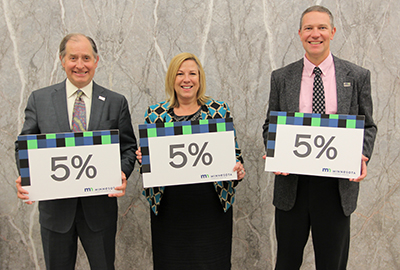
Commissioner Charlie Zelle, Karin Van Dyck, Human Resources director, and Eric Davis, chief of staff, hold up 5 percent signs. That is the goal for state agencies in the State Combined Charities Campaign. Photo by Rich Kemp |
Co and district coordinators are sending out post cards and emails to encourage employees to pledge their support.
The Central Office is combining efforts with the departments of Admin, Revenue and Health to host a marketing event Oct. 9 for the campaign. Employees who attend may discuss charitable giving options with representatives from Community Health Charities, Community Shares MN, Greater Twin Cities United Way, Minnesota Environmental Fund, Open Your Heart to the Hungry & Homeless, PeaceMaker MN and Women’s Foundation of MN. There will be pizza and games available at the event held in conference rooms G13 and G14 from 11 a.m. – 1:30 p.m.
Employees can participate in the Minnesota State Combined Charities Campaign by pledging online to make a gift to the charity of your choice through the convenience of payroll deduction. Visit https://mn.gov/mmb/combined-charities/charities/ to learn about the charity federations, their affiliated partners, and how your donations can make a difference in your community. Pledging occurs online at the State of Minnesota’s self-service website. Payroll deductions begin with your first paycheck in 2017. Even a pledge of $1 or $3 per pay period can make a difference in your community and provide another example of how “We Care. We Give.”
Contact the district Combined Charities Campaign coordinator if you have any questions:
District 1 – Karen Bohjanen
District 2 – Joe McKinnon
District 3 – JP Gillach
District 4 – Kayla Pavlacky
District 6 – Debbie Tlougan
District 7 – Doris Degenstein
District 8 – Linda Vandendriessche
Metro – Maureen Widmer
Central Office – James Pontius |
 |
|

|
 |
TABLE of CONTENTS
 |
A job with a view |
By Sue Roe
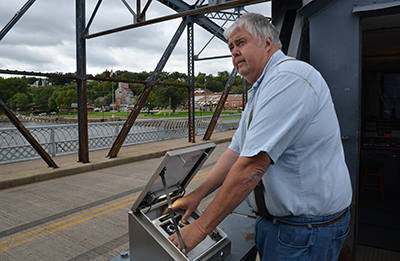
With downtown Stillwater in the background, Mike Schmidt closes the crossarms on the Stillwater Lift Bridge prior to lifting a section of the bridge for river traffic. Photo by Sue Roe |
Every weekday, Mike Schmidt drives 38 miles from his home to the Stillwater Lift Bridge, parks his truck and walks halfway down the bridge to the “tender shack.” There, he spends the next eight hours waiting for a paddleboat, fishing boat or other vessel to request his services to lift the bridge on the St. Croix River so they can pass.
“The paddleboats are the biggest and tallest boats that go through,” said Schmidt. “The big paddleboat company can clear the bridge with four out of five of its boats. The small cruisers, pontoons and houseboats can all pass without lifting the bridge. There are lots of $100,000 boats and up to $400,000 that travel the river.”
As the lift bridge operator, or bridge tender, Schmidt’s main job is to lift the historic bridge for boat traffic every 30 minutes as needed. Before the bridge closed permanently to motor vehicles last month, Schmidt also had to watch for vehicles and pedestrians to make sure they were behind the stop arms before the lift bridge began its ascent. Work is under way to repair and restore the bridge and renovate it to its 1931 appearance. The bridge will reopen as a bicycle and pedestrian bridge and will become part of the 5-mile loop trail system connecting existing local and regional trails in Minnesota and Wisconsin.
“It’s so calm now,” Schmidt said about the bridge closure. “This road used to be so busy that you couldn’t hear us talking right now.”
But the river traffic continues and so does Schmidt’s work. The bridge is open from mid-May to mid-October, seven days a week, from 8 a.m. to midnight. Two other MnDOT bridge tenders, Andrew Peterson and Peter Zeimann, work the 4 p.m. to midnight and weekend shifts.
If boaters request a lift any other time, they have to call the Regional Transportation Management Center so one of MnDOT’s 21 bridge tender qualified employees can do the lift.
This is Schmidt’s third stint as a bridge tender. The 36-year MnDOT employee did the job about 10 years ago and then again last year. Employees bid on the three openings each summer.
“I like the tranquility of it,” Schmidt said. “You’re by yourself, watching the river and the boats.”
There’s also a television in the tiny shack, the newspaper Schmidt brings every day, magazines and a hand-held Yahtzee game. There aren’t many modern conveniences in the shack so when he takes an occasional short walk to nearby downtown Stillwater he brings his two-way radio with him in case a boater calls ahead for a lift.
Each lift takes 10 to 15 minutes. The first step is to sound one long blast of the gong and turn on the lights to signal traffic that the bridge is starting its ascent.
“The control panel activates the lift mechanism,” he said as he pushes buttons for the gates to close and the lift to begin. He can also control the gates from a panel outside the shack.
He explains how the lift mechanism operates using a system of counterweights, cables and pulleys to raise and lower an 80-foot section. The tender shack sits just off that 80-foot section and lifts when the bridge does. At its full height, it’s 42 feet in the air, giving boats a minimum of 8 feet of clearance.
After the boats clear the bridge, Schmidt’s final step is to sound two short blasts before the bridge descends. With each ascent and descent, visitors and residents of Stillwater walking along the river edge stop to watch.
Schmidt checks the water level daily since that determines what sizes of boats may need the bridge lifted that day. He said earlier in the year, the water level was so high that there was only a 3-foot clearance between the water and the bridge.
“In flood stage, the water is so high that the lift bridge stay ups until the water goes down,” he said.
On Labor Day, the traffic kept Schmidt busy.
“We do a lift every half hour so there are 16 chances for lifts every eight hours. I lifted for 15 that day,” Schmidt said.
He records the number of boats going through each lift and reports it to MnDOT and the U.S. Coast Guard.
In late July, the bridge lost power when a transformer blew and the bridge was stuck in a lift position, stranding Schmidt 30 feet high for eight hours. Employees from the Forest Lake bridge crew and Electrical Service Unit worked on the bridge and during a test run after the repair, those workers also got stuck for a short time. A truck with an aerial basket was brought in to bring Schmidt and the other workers down.
As the lift season comes to a close, Schmidt, who is a transportation generalist out of the Spring Lake Park truck station, will transition to other work of the upcoming winter season.
“I’ll go back to my truck station as a maintenance worker and start 12-hour shifts of snowplowing,” he said.
|
Other bridges with bridge tenders
Aerial Lift Bridge, Duluth, Minn – Owned by the city of Duluth and operates 24-hours per day from March to January. This bridge, like the Stillwater Lift Bridge, also operates on a system of counterweights, cables and pulleys. It was built in 1905 as a transporter bridge and converted to an aerial vertical lift in 1929.
Bascule Bridge, Prescott, Wis.- Crosses the St. Croix at Hwy. 10 and is operated by the state of Wisconsin. The end of the bridge has a large round gear on it and a matching flat gear operated by hydraulics. When the flat gear is moved, the round gear spins, tipping the bridge deck into the air. It was built in 1990, replacing a lift bridge. This bridge is also known as a drawbridge.
Swing Bridge, Hudson, Wis. – Owned and operated by the Union Pacific Railroad, it crosses the St. Croix River. It has a turning span that pivots horizontally. It was built in 1912. |
|
 |
|

|
 |
TABLE of CONTENTS
 |
Employees continually push to improve MnDOT’s work |
By Deputy Commissioner Tracy Hatch, chief financial officer and chief operating officer
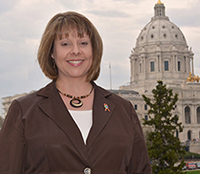
Tracy Hatch, deputy commissioner, chief operation officer and chief financial officer. Photo by Rich Kemp |
“Continuous improvement is better than delayed perfection.” – Mark Twain
Next week, MnDOT employees will receive an email with an invitation to participate in the state’s Biennial Continuous Improvement Index Survey. I ask that you set aside 10 to 15 minutes to complete the survey. Your responses will help us keep improving as an agency to better serve the citizens of Minnesota.
The CI Index Survey is a part of Gov. Dayton’s Better Government for a Better Minnesota initiative, in partnership with the Minnesota Office of Continuous Improvement at the Department of Administration. Many of you participated in a similar survey in 2015, which serves as a baseline for this follow-up survey. The survey’s purpose is to gather data about our agency’s change readiness and continuous improvement culture. All executive branch state employees are being asked to complete the survey.
MnDOT’s Senior Leadership Team expects to receive the survey results in early 2018. The report will show our progress towards becoming a continuously improving organization and include customized recommendations for our agency. We will share these results with you.
MnDOT employees are no strangers to improving our processes and products. In recent years, we grouped these efforts under the umbrella of our Wildly Important Goals—starting with WIG 1.0, Enhancing Financial Effectiveness, and continuing with WIG 2.0, Earning Customer Trust. Check out the WIG website to see our many accomplishments to date as an agency. They demonstrate the depth and breadth of the creative engine driving our workforce, always looking for ways to improve the status quo to benefit the people we serve. |
 |
|

|
|



